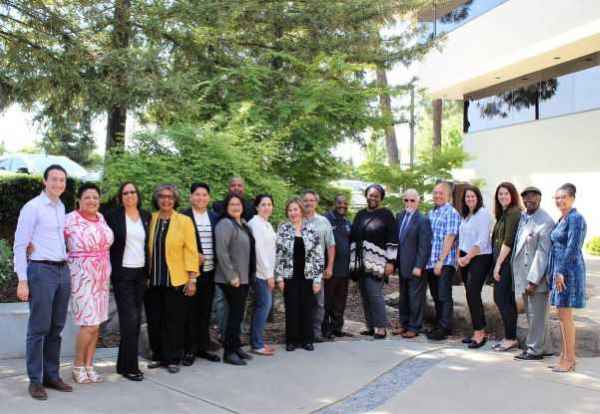Returning to their districts with a lens focused on equity and action plans in hand, a group of 20 school board members from across California completed their CSBA Equity Network experience on April 26–27 in West Sacramento. The two days of deep reflection and discussion on critical public education equity issues capped a series of in-person and online sessions dating back to August 2018.
CSBA’s inaugural Equity Network was funded through generous planning and implementation grants from the Stuart Foundation. The foundation has awarded an additional grant to continue the project, with CSBA currently planning for a second-year cohort of 20 additional board members and support activities for the participants of the first-year cohort.
Opening year one’s final session, participants said they have already used reflections and equity concepts learned through the network to influence board and district discussions around issues such as student achievement, labor agreements and hiring practices.
Manuel Buenrostro, CSBA education policy analyst and network staff liaison, said board members’ important work will not end simply because the sessions are over. “Being an equity-focused leader means that the work is ongoing,” he said. “The board members that made a commitment to this work are committed to continuous learning and can be an inspiration for other board members across the state.”
Some of the core concepts the sessions addressed were implicit bias, microaggressions, structural racism, stereotyping, white supremacy and cultural humility.
The sessions were led by Nicole Anderson, the network’s lead consultant and facilitator and Deborah Keys Write, former National School Boards Association director of equity programming and current consultant.
The facilitators and presenters emphasized self-reflection and a thorough review of current board and district practices, whether implicit or explicit. Keys Write said true equity efforts are not a matter of checking a box, but rather of driving a culture that permeates “from the boardroom to the classroom, and everyone in between.” Keys Write also emphasized that “there are districts that are talking about diversity, but they’re not doing anything about.”
Keys Write and Anderson also discussed the importance of going beyond assessment scores and California Schools Dashboard data to find a true representation of a district’s equity challenges; methods include student and parent surveys and interviews about their experiences, as well as equity walks at school sites. “You can’t close gaps if you don’t where your gaps are,” Keys Write said.
Participants agreed that a balanced perspective of a person’s cultural identity and background is integral to the conversation. Anderson said even the best-intentioned policies might not improve equity if its authors haven’t stopped to consider what a student group actually needs to improve academic and life outcomes.
Jefferson Union High School District board vice president Kalimah Salahuddin said she finds it critical to share data and cultural information with people when discussing equity issues. “Things that I feel like everyone knows, everyone doesn’t know,” she said, citing examples such as data that the likelihood of African American men being incarcerated greatly hinges on whether they attend college.
The network’s final activity saw board members form equity plans based on an area they wanted to focus on in their districts. Included in the exercise was how the planned steps aligned with their district’s Local Control and Accountability Plan and what measurable data could be used to track progress and ensure accountability.
This year’s Equity Network participants were from Bakersfield City Elementary School District, San Diego USD, Monterey Peninsula USD, Salinas Elementary School District, Salinas Union High School District, Elk Grove USD, Washington USD, Fairfield-Suisun USD, Manteca USD, Alhambra USD and Jefferson Union High School District.





